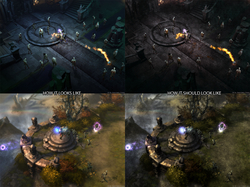 There has been many debates on the graphic level of Diablo 3 and how it should be different. Finally a developer comes out and says “um, no.” Their reasoning is fairly simple, it’s one thing to photoshop up a screenshot with some filters but it’s another to get the texture and lighting to run at that detail on a standard computer.
There has been many debates on the graphic level of Diablo 3 and how it should be different. Finally a developer comes out and says “um, no.” Their reasoning is fairly simple, it’s one thing to photoshop up a screenshot with some filters but it’s another to get the texture and lighting to run at that detail on a standard computer.
How do you argue with that? Personally, I think the graphics look wonderful, brilliant, vibrant and professional. Diablo 3 game designer Jay Willson said:
“The key thing to remember here is that this has been Photoshopped. This isn’t created by the engine. Though it looks really cool, it’s almost impossible to do in a 3D engine because you can’t have lighting that smart and run on systems that are reasonable. If we could do that, we probably would in a few of the dungeons.” (slashdot)
Non-developers seem to forget that the colors, cameras and lighting don’t come free on a video game. Everything has limitations and, although the limitations change over time, today’s graphics for a standard machine are capable of running Diablo 3. Blizzard isn’t making a game that only hardcore PC gamers can play, this game is for everyone.
Building a video game is a lot of smoke and mirrors to make a virtual object look “real” to normal gamers. Immersion and definition is important, grainy dark graphics do set a mood, but they also frustrate many players. Remember DOOM 3? Some people could barely see the “epic graphics” of the last DOOM sequel, it’s time to mature and show off true colors.
Darkness usually is used to hide imperfections, Diablo 3 has nothing to hide.
(For a high resolution photo, checkout MTV Multiplayer Blog)

 Now that Blizzard feels their engine is solid, it’s time to move on to creating content for the full game. Jay Wilson, Diablo 3‘s lead designer, says the game engine is in an advance stage of completion and much of the art team has moved onto Act 2. Don’t read into that, he said game engine.
Now that Blizzard feels their engine is solid, it’s time to move on to creating content for the full game. Jay Wilson, Diablo 3‘s lead designer, says the game engine is in an advance stage of completion and much of the art team has moved onto Act 2. Don’t read into that, he said game engine. You’re looking to pickup a copy of Guitar Hero World Tour, but you’re currently unsure which bundle does what and how much each will cost. That has now been made clear and gamers can go about their holiday shopping business later this month (Oct. 26th) to pickup the bundle of their choosing.
You’re looking to pickup a copy of Guitar Hero World Tour, but you’re currently unsure which bundle does what and how much each will cost. That has now been made clear and gamers can go about their holiday shopping business later this month (Oct. 26th) to pickup the bundle of their choosing.
http://www.penny-arcade.com/comic/2008/8/6/crimson-clad/
Hee, hee.
It’s funny to see how much to world has changed because of the internet. There was a time when fans couldn’t wait for a new game to be released, and now-a-days fans critique to work of developers before even having played the games themselves. People have always slammed me for being really into graphics and are always quick to tell me how “the game play makes a game, not the graphics”. I can’t wait to play Diablo III but I think I will wait to actually play it before judging the game. Interesting article.
I remember calling Dynamix to talk amiably about a gameplay problem (field goals too difficult because the kickers have no power – keep in mind, this was before the age of sliders), and spoke to the lead designer. He sent me a disk that patched the game, and later sent me a free Pro upgrade.)
I miss those halcyon days.